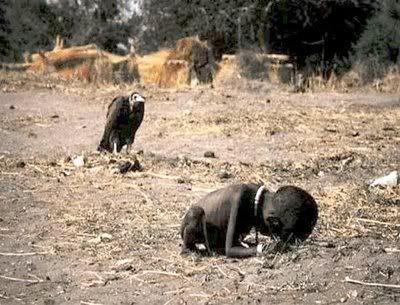English was pretty alright, I guess. Hopefully I'll get at least a 8.5!
I'm currently doing Australian Studies - the last 2 chapters. I'm stressing out because there are no notes, study guides, no whatsoever for the last two topics - contemporary issues, and one may be coming out for the extended response essay. It's on weds, RIGHT AFTER ECONS. What a killer.
Also I have soooo much to blog about, especially on the grad ceremony and party- which was a B-L-A-S-T! People who didn't go missed out on A-L-O-T!
I HAVE to start on media soon, because I have not even TOUCHED it yet. It's tmr, and its the last paper of the day - 2.50 - 5. Craaapppppp.
Ohkay. Got a splitting headache now. Since yesterday. I think it's the studying. Hmmmm
Okay la back to Stolen Generation and Reconciliation, Citizenship tests and whatnot. Oh wait. Let me show you this....

Kevin Carter was an award-winning South African photojournalist and member of the Bang-Bang Club.
Carter had started to work as weekend sports photographer in 1983. In 1984 he moved on to work for the Johannesburg Star, bent on exposing the brutality of apartheid.
Carter was the first to photograph a public execution by "necklacing" in South Africa in the mid-1980s. He later spoke of the images; "I was appalled at what they were doing. I was appalled at what I was doing. But then people started talking about those pictures... then I felt that maybe my actions hadn't been at all bad. Being a witness to something this horrible wasn't necessarily such a bad thing to do."
In March 1993 Carter made a trip to southern Sudan. The sound of soft, high-pitched whimpering near the village of Ayod attracted Carter to a young emaciated Sudanese toddler.
The girl had stopped to rest while struggling to a feeding center, wherein a vulture had landed nearby. He said that he waited about 20 minutes, hoping that the vulture would spread its wings. It didn't. Carter snapped the haunting photograph and chased the vulture away.
However, he also came under heavy criticism for just photographing — and not helping — the little girl:
"The man adjusting his lens to take just the right frame of her suffering might just as well be a predator, another vulture on the scene."
The photograph was sold to The New York Times where it appeared for the first time on March 26, 1993. Practically overnight hundreds of people contacted the newspaper to ask whether the child had survived, leading the newspaper to run a special editor's note saying the girl had enough strength to walk away from the vulture, but that her ultimate fate was unknown.
On April 2, 1994 Nancy Buirski, a foreign New York Times picture editor, phoned Carter to inform him he had won the most coveted prize for photography. Carter was awarded the Pulitzer Prize for Feature Photography on May 23, 1994 at Columbia University's Low Memorial Library.
On 27 July 1994 Carter drove to the Braamfonteinspruit river, near the Field and Study Centre, an area where he used to play as a child, and took his own life by taping one end of a hose to his pickup truck’s exhaust pipe and running the other end to the passenger-side window. He died of carbon monoxide poisoning at the age of 33.
Portions of Carter's suicide note read:
"I am depressed ... without phone ... money for rent ... money for child support ... money for debts ... money!!! ... I am haunted by the vivid memories of killings and corpses and anger and pain ... of starving or wounded children, of trigger-happy madmen, often police, of killer executioners...I have gone to join Ken if I am that lucky."
No comments:
Post a Comment